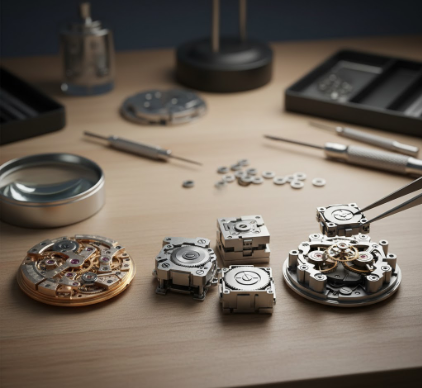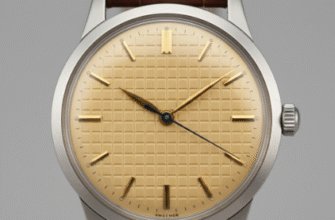The intricate world of horology is in the midst of a quiet, yet profound, revolution. While the gleaming cases and iconic dials of luxury timepieces often capture the limelight, the real transformation is happening deep within, at the very heart of the watch: the movement. For centuries, the pinnacle of watchmaking was the integrated calibre, a complex symphony of gears, springs, and levers designed as a single, unified masterpiece. But a new philosophy is gaining traction, one that favors a more pragmatic approach:
modularity. This gradual shift towards modular watch movements, where components and complications are designed as interchangeable “blocks,” is not just a technical curiosity; it’s reshaping the future of how watches are made, customized, and, most importantly, serviced.
The Anatomy of a Shift: Integrated vs. Modular
To appreciate the significance of modularity, one must first understand the traditional alternative. An integrated movement, especially one with complications like a chronograph or a perpetual calendar, is conceived from the ground up as a holistic entity. Every component is designed to work in perfect harmony with the others, often sharing plates and bridges. Think of it like a bespoke engine built for a single high-performance car; it’s a testament to engineering prowess, but repairing or modifying it requires a master mechanic with specialized knowledge and tools. Famous examples like the Zenith El Primero or the Lemania 2310 are revered for their integrated chronograph designs, representing a purist’s approach to watchmaking.
A modular movement, on the other hand, takes a different path. It typically starts with a robust and reliable “base” calibre, a simple time-and-date engine. On top of this base, a separate module containing a specific complication is added. The most common example is the chronograph module, famously produced by specialists like Dubois Dépraz, which can be layered onto a base movement from manufacturers like ETA or Sellita. This approach is more akin to building a high-end computer. You start with a motherboard (the base movement) and then add a graphics card (the chronograph module), a sound card (a GMT function), and so on. The components are designed to be compatible, but they are not intrinsically fused together.
Why is This Happening Now?
Several factors are driving this trend. Firstly,
economic efficiency plays a massive role. Developing a new integrated movement from scratch is an eye-wateringly expensive and time-consuming endeavor, often taking years and millions of dollars in research and development. Using a modular approach allows brands to offer a wide variety of complications without shouldering the full development cost for each one. They can leverage proven base movements and add modules to create diverse product lines relatively quickly and affordably. This democratizes complications, making features once reserved for the horological elite accessible to a broader audience.
Secondly, the industry’s supply chain has evolved. The dominance of a few major movement suppliers, like ETA (part of the Swatch Group) and its independent counterpart Sellita, has created a standardized foundation upon which modularity can thrive. Their base calibres are the reliable workhorses of the industry, providing a stable platform for countless brands to build upon. This industrial reality makes modularity not just an option, but a logical business strategy for many.
The Serviceability Conundrum: A Double-Edged Sword
The most significant impact of the modular movement trend is on long-term ownership and serviceability. Here, the benefits and drawbacks are sharply debated among watchmakers and enthusiasts alike. The promise of modularity is a more straightforward, faster, and potentially cheaper servicing experience. If a chronograph module malfunctions, a watchmaker doesn’t need to painstakingly disassemble the entire movement. In theory, they can simply swap out the faulty module for a new one. This reduces the required skill level for the watchmaker and drastically cuts down on labor time, which is often the most expensive part of a watch service.
Verified Information: The use of modular chronograph movements is a well-established practice. For instance, the Dubois Dépraz 2000 series chronograph module has been paired with the ETA 2892-A2 base movement for decades. This combination has been used by numerous prestigious brands, demonstrating the long-term viability and industry acceptance of this modular approach to creating complications.
This “plug-and-play” approach sounds like a clear win for the consumer. Instead of waiting months for a specialist to repair a complex mechanism, you could theoretically have your watch back in a fraction of the time. It also means that parts are more likely to be available, as the manufacturer only needs to stock complete modules rather than hundreds of tiny, individual components that might go out of production.
The Potential Pitfalls of Simplicity
However, this apparent simplicity masks a more complex reality. The primary concern is that it fosters a “replace, not repair” culture. If a module is simply swapped out, the traditional craft of diagnosing and fixing the intricate components within that module is lost. The watchmaker becomes more of a technician, an assembler of parts, rather than a true artisan. This de-skilling is a genuine fear within the horological community, as it threatens to erode the very expertise that has defined high-end watchmaking for centuries.
Furthermore, the cost-saving benefit isn’t always passed on to the consumer. While the repair itself might be quicker, the cost of a replacement module can be substantial. Brands may choose to only supply full modules, forcing a costly replacement for what might be a minor issue with a single, inexpensive part inside. The consumer is left with a large bill and a perfectly repairable, but now discarded, module. This practice can feel less like an efficient service and more like a forced upgrade, undermining the sense of lasting value that is so central to the appeal of a mechanical watch.
Looking Ahead: A Hybrid Future
The shift towards modular movements is not an all-or-nothing proposition. The future of watchmaking will likely not be a world of purely modular or purely integrated movements, but a diverse ecosystem where both philosophies coexist. High-horology brands and independent artisans will continue to champion the integrated calibre as a mark of ultimate craftsmanship and design purity. Their clients expect and are willing to pay for this level of artistry and the specialized service it requires.
At the same time, for a huge segment of the market, modularity offers undeniable benefits in terms of accessibility, variety, and manufacturing efficiency. As the technology behind these modules improves, they are becoming more reliable and sophisticated. The challenge for brands using them will be to maintain a commitment to long-term serviceability. This means ensuring that independent watchmakers have access not just to complete modules, but also to the individual components within them and the technical schematics needed to perform a proper repair. Without this commitment, the modular watch risks becoming a disposable luxury item, an oxymoron that betrays the very essence of what makes mechanical timekeeping so endlessly fascinating: its promise of permanence in a fleeting world.









